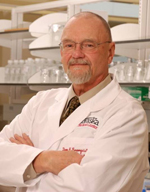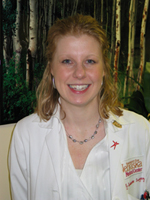 |
Tom Rosenquist, Ph.D. |
 |
Michelle Vitamvas |
But two months after she was born, Vitamvas was diagnosed with Tetralogy of Fallot — a heart defect that caused her to have a blue appearance because of reduced oxygen in the blood. She’s had three open-heart surgeries during her life to repair the defect.
But Vitamvas, now 32, and others born with congenital heart defects are living healthy, productive lives thanks to research advances such as those forged by UNMC’s Tom Rosenquist, Ph.D., and his team.
“We live in a society where our resources for research and technology are abundant, advanced and it’s a very hopeful time we live in,” said Vitamvas, a nurse coordinator in the UNMC Department of Surgery. “There’s hope for children born with heart defects. I’m living proof of it.”
Dr. Rosenquist and his research colleagues have dedicated their lives to helping reduce the death and devastation of congenital heart defects — the most common cause of birth defect-related deaths.
Dr. Rosenquist, UNMC vice chancellor for research, heads a $5.6 million program project grant composed of three teams of scientists investigating how genes interact with certain drugs, environmental exposures and vitamin deficiencies to cause abnormal heart development.
The five-year grant is the first National Institutes of Health-funded grant to test a unifying hypothesis for this type of gene/environment interaction.
|
Dr. Rosenquist’s team was the first to show an association between genes and the body’s ability to absorb folic acid. They also were first to demonstrate the biological basis for the risk imposed by a rise in homocysteine when folic acid is low, a risk that was first shown to be associated with impaired development of the spinal cord, brain and heart in humans by the group in Neijmegen.
“We’re trying to figure out what some of the susceptibilities are in the mother’s diet, folate and B-12 levels in the blood, the relationship between environmental exposures during pregnancy, and a variety of gene mutations,” Dr. Rosenquist said. “We call it gene-environment interaction. That is where this type of research is going in the 21st century.”
|
|
Dr. Rosenquist’s group has been able to produce the defect in a reliable experimental model and have found certain combinations of gene mutations and environmental exposures that predict its occurrence.
The objective of Dr. Rosenquist’s group is to develop reliable methods to predict, and ultimately prevent heart defects so people like Vitamvas may be spared the complications and surgeries that go along with some defects.
Ultimately, Dr. Rosenquist said, he would like to see tests developed that can predict the probability of having a baby with heart defects.
Click here to see video related to this story.